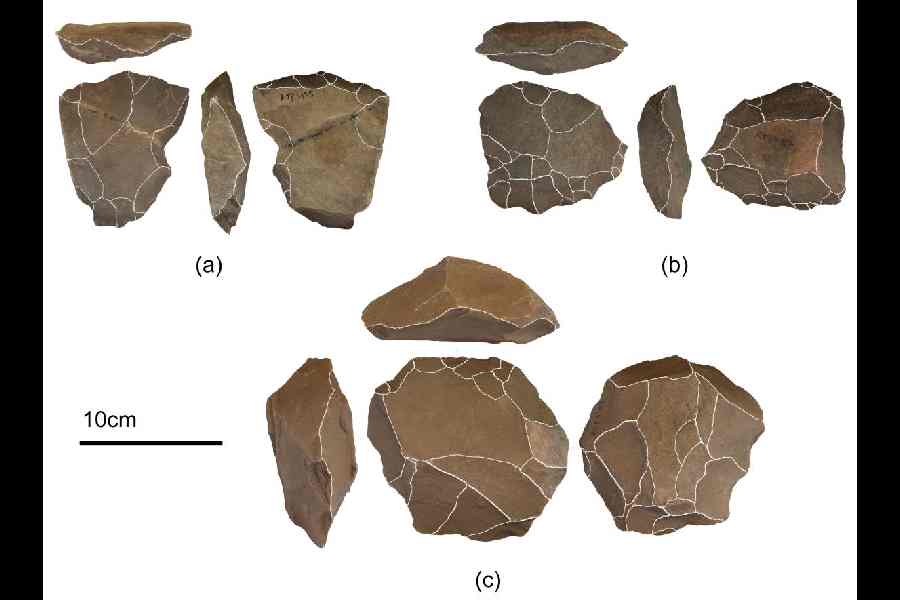Archaeologists have recovered from a site in Andhra Pradesh 139,000-year-old stone tools that challenge longstanding assumptions that only modern humans could make such sophisticated tools and deepen the mystery of the toolmakers’ identity.
The excavations near a village named Retlapalle in Prakasam district have yielded the so-called “middle-paleolithic” stone tools that archaeologists say support the idea that certain extinct ancestors on the human family tree had also acquired the stone-making craft.
The cache of several hundred stones, crafted into oval, triangular or pointed tools to serve as blades, cutters or scrapers, come from a time when Homo sapiens, or modern humans, had not migrated out of Africa to reach South Asia.
“The identity of the toolmakers in Retlapalle remains a mystery,” Anil Devara, an assistant professor of archaeology at the Maharaja Sayajirao University, Baroda, who led the excavations, told The Telegraph.
Devara and his colleagues from academic institutions in India and Germany published their findings in the journal PLOS One this week.
The mystery began to take shape nearly two decades ago when another archaeological team discovered similar stone tools at Attirampakkam, a prehistoric site about 60km west of Chennai. The Attirampakkam tools were estimated to be between 372,000 and 170,000 years old.
Genetic evidence that emerged over 25 years ago suggests that people around the world today are descendants of modern humans who trudged out of Africa between 60,000 and 70,000 years ago. But an independent archaeological study at Jwalapuram in Andhra Pradesh a decade ago had found 77,000-year-old stone tools, prompting some researchers to argue that Homo sapiens antiquity in India might date back to 125,000 years ago.
Researchers had earlier found even older stone tools in India. Prehistorians Shanti Pappu and Kumar Akhilesh at the Sharma Centre for Heritage Education, for instance, have recovered 1.5 million-year-old tools from Attirampakkam. A site in Karnataka too has yielded 1.2-million-year-old tools.
But researchers classify these older tools as “Acheulian” tools made by the extinct ancestral species called Homo erectus that once roamed across Africa and Asia between 1.6 million years ago to at least 250,000 years ago.
“Typical Acheulian tools such as hand axes or cleaversare much larger and older than the middle-paleolithic tools that came much later,” Devara said.
“In the middle-paleolithic tools, we see evidence of pre-determined planningand shaping, which was long believed to have evolved in Homo sapiens.”
But, Devara said, the middle-paleolithic tools from Ratlepalle and Attirampakkam in India and similar discoveries in Europe have put a “bigquestion mark” on the assumption that such tools emerged only after the arrival of modern humans.
Pappu, who has been studying the Attirampakkam site for two decades and was not associated with the Ratlepalle findings, said a conspicuous absence of any fossilised remains of ancestral human species from such sites in South Asia was a challenge.
“With no bones, we cannot associate these tools whether at Attirampakkam or Ratlepalle with any specific species,” she told The Telegraph over the phone from Chennai. “Who made these tools remains an open question.”
Devara said there was now growing evidence that similar middle-paleolithic tools had emerged around the same time in Africa, Europe and South Asia, but before modern humans arrived in Europe or Asia.
“What this suggests is that the same tool-making technology may have evolved independently in different species -- in modern humans in Africa, perhaps in the Neanderthals in Europe, and perhaps in some other archaic human species in South Asia,” Devara said.
A skull recovered from the banks of the River Narmada in 1982 and assigned dates between 150,000 and 200,000 years ago remains the oldest ancient human fossil from India so far. Scientists have attributed the lack of archaic human remains to South Asia’s humid climate, rains, the nature of the soil and the limited funds for fossil hunting.











